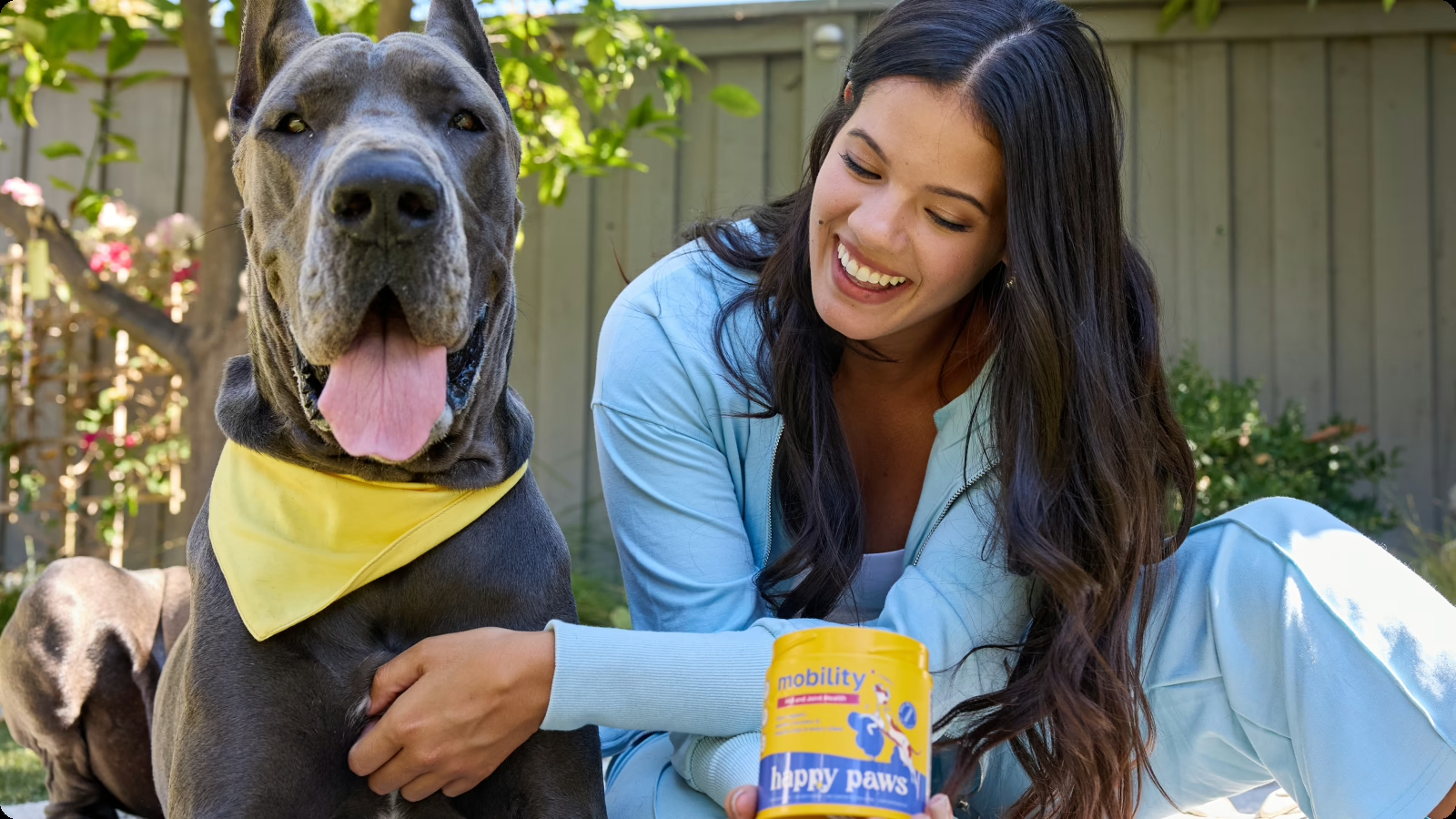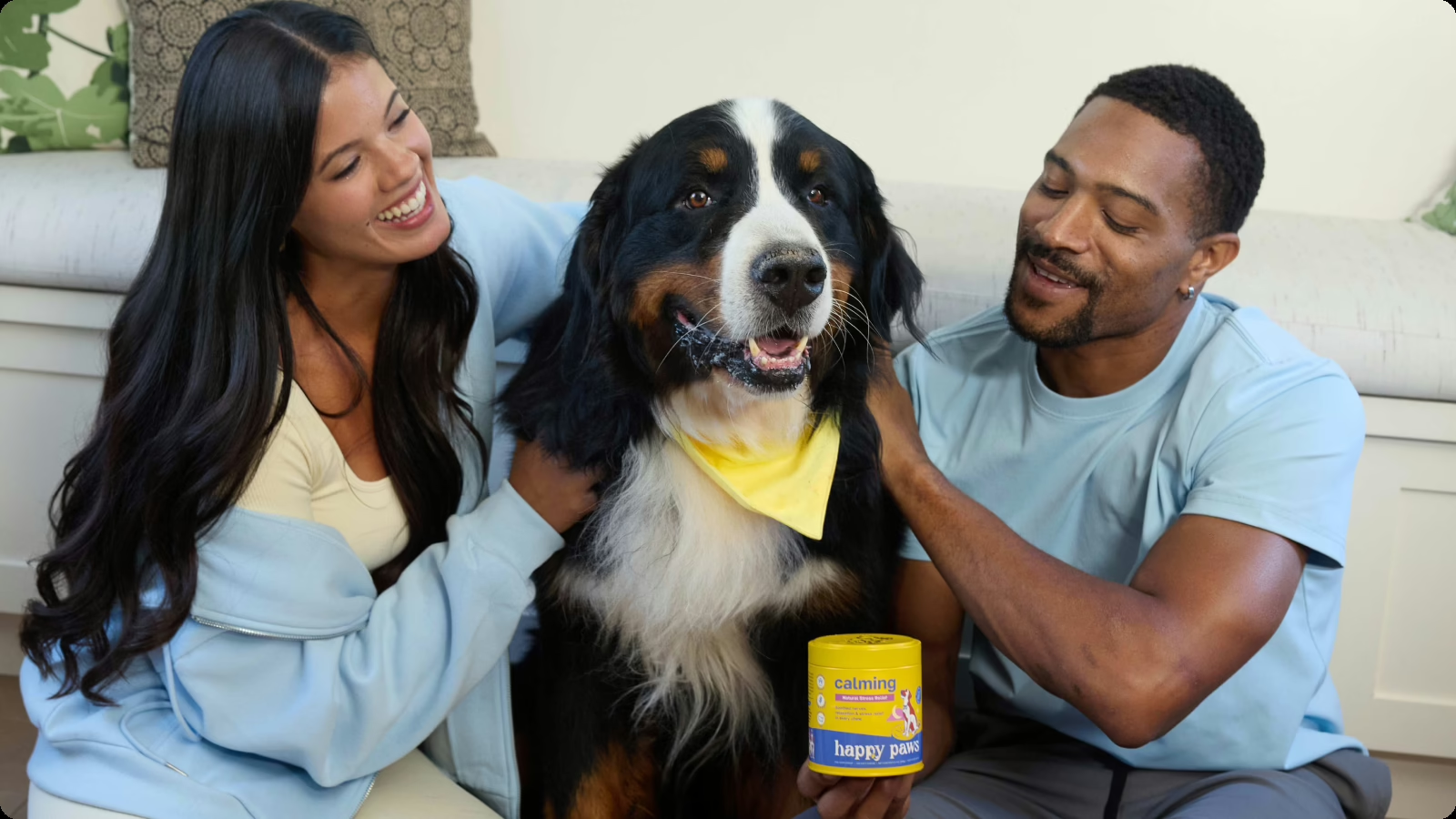Joint supplements for dogs are one of the most popular healthy treats pet parents use. These tasty, vitamin-packed chews contain a multifaceted blend of nutritious, joint-friendly ingredients, all to help your dog wiggle, zoom, and frolic a little bit easier. Two primary ingredients in these chews are chondroitin (kon-DROIT-in) and glucosamine (gloo-KOH-suh-meen). You, me, and your pupper all have varying levels of glucosamine and chondroitin in our bodies right now. And as we all get older, this concentration falls, potentially leading to a wide range of joint woes.
In this article, we’ll explore what these joint-boosting ingredients are, what they do, and why their absence can spell mobility problems for your dog. We’ll also touch base on a few other ingredients in the starting line-up next to this dynamic duo. But first, let’s take a close look at your dog’s joints, and explore why joint health matters.

What Happens to Your Dog’s Joints
A dog’s joints are constructed much like ours: two bones joined together, fitted perfectly like puzzle pieces with ligaments, cartilage, and tendons for support and cushion. When your dog’s a puppy or young adult, their joints are healthy and fully stocked with the necessary resources to leap, jump, dive, and flop wherever their little brain tells them to. But, after thousands of steps, hundreds of runs, and tens of jumps, your dog’s joints can gradually wear down, losing their ability to keep up with your pup’s active spirit. With weight gain and poor nutrition, this decline in joint health can quicken, leading to a number of issues.
Osteoarthritis
Believe it or not, a dog’s osteoarthritis is much like ours. Inside your dog’s joint, special lubricant and cartilage padding help keep bone-on-bone contact. As your dog runs, skips, and swerves, the cartilage padding and lubricant go to work, bracing your dog’s joints for impact and awkward falls. But, as they age, your dog won’t have the necessary resources to keep these areas up to snuff. As your dog gets older, the lubrication in the joint gradually dries up, and the cartilage slowly wears down, potentially leading to bone-on-bone contact. This is called osteoarthritis, and while it’s not curable, it is treatable.
If you believe your dog has osteoarthritis, it’s always best to consult a professional vet for next steps. In fact, osteoarthritis might be more common than you think. The American Kennel Club says that around 80% of senior dogs show signs of arthritis.
Decreased Activity
When your dog’s joints aren’t up to snuff, your pup might experience minor pain or discomfort when walking, running, or jumping off the couch. This can cause them to stay in their bed or reside on the couch, as a wisened watcher. The issue here is that daily movement and light exercise are essential for all dogs, regardless of age, size, or breed. Daily movement and light exercise can help keep your dog’s weight in check and can even boost cognitive health. So, when your dog’s activity levels decrease, other facets of their health can, too.
Signs of Poor Joint Health in Dogs
Many dog owners don’t know what to look for when it comes to their pet’s joint health. Here are a few common signs that may indicate poor joint health.
- Limp: Your dog’s hips and joints may not weaken at the same rate, so many dogs tend to favor one side, causing a noticeable limp.
- Stiffness: Joint stiffness can stem from a lack of padding (called cartilage), causing the joint to lose its movement and flexibility. Dogs with this condition may walk or run with an awkward stiffness around their knees and hips.
- Hesitancy to jump, play, or walk up stairs: If a dog has pain when jumping, running, or climbing up steps, they may be hesitant in moments that require this movement.
- Lethargy: Poor joint health can affect your dog’s willingness to get up and play. So, they may just linger on the couch instead of joining you for playtime.
- Irritability when touched or petted: For some dogs, poor joint health can lead to pain or increased sensitivity around the affected areas. Dogs with conditions like this can grow irritable when you pet or graze their hips or joints.
If you see one or more of these signs in your, it’s always best to consult a vet. They will be able to discern your pet’s unique conditions, rule out other factors, and offer a curated list of next steps to help improve your dog’s mobility. Vets are our best friends; they should be your dog’s, too!
What Is Glucosamine?
Glucosamine is a naturally occurring, mild anti-inflammatory compound that serves as an essential building block in your dog’s cartilage. As your dog ages, their natural supply of glucosamine dwindles, leading to joint woes and potential mobility pain. Many joint supplements, including those for humans, use glucosamine as a key ingredient. When supplemented, glucosamine can help replenish your dog’s natural stores of glucosamine, which, in turn, can replenish the padding in their joints.
What Is Chondroitin?
Chondroitin, on the other hand, plays a vital role in preserving your dog’s joint health. This compound helps preserve connective tissue from breaking down and even replenishes cartilage production. When paired with glucosamine, chondroitin helps provide functional benefits that can promote mobility.

Why Choose Chondroitin & Glucosamine Supplements
There are a few reasons pet parents turn to joint supplements with both chondroitin and glucosamine.
All-in-One, Joint-Boosting Blend for Dogs
Instead of giving their pets multiple joint-friendly supplements, dog owners like to use supplements that combine the two important ingredients. This all-in-one, joint-boosting blend lets owners remember to give just one supplement a day, instead of running around the kitchen, looking for a measuring spoon, and grabbing each individual tin of supplements. All-in-one joint chews come premeasured with accurate serving sizes, letting you spoil your dog with all-natural, high-quality ingredients once or twice daily.
Healthy Ingredients in the Form of a Tasty Treat
“Healthy” doesn’t always taste good, even for dogs who love eating just about anything. So, that’s why it’s important to find a chondroitin and glucosamine supplement that carries a dog-approved flavor. We make our Mobility Dog Chews with a natural, vegan bacon flavor, all to entice even the pickiest puppers.
Vet-Approved Formulas
Anytime you’re giving your dog supplements, it’s always best to do so under the guidance of your vet. Your vet will know your dog’s unique circumstances and will be able to recommend important next steps. They’ll also be able to decide if a supplement is best for your dog—and which one.
We make all of our supplements with vet-approved formulas. Our team of vets has helped us fine-tune our formulas and perfect the doses. We’re proud to work with pet-lovin’ vets!
Additional Joint-Friendly Ingredients for Dogs
Alongside glucosamine and chondroitin, we also pack in a number of additional joint-boosting ingredients into our hip and joint mobility soft chews.
Methylsulfonylmethane (MSM)
Methylsulfonylmethane (MSM) is often used to treat symptoms of arthritis, reduce inflammation, and even promote stronger immunity. We’ve added it to our joint supplements to help round out the benefits and deliver even better joint-boosting effects.
Green Lipped Mussels
Their name might sound peculiar, but green lipped mussels are a common feature in many joint supplements for dogs. These shelled mussels are native to New Zealand and have quickly found a niche as a nutritional supplement, for dogs and their owners. These mussels deliver potent anti-inflammatory benefits that can promote joint health. Plus, they contain a variety of vitamins, omega fatty acids, and minerals that can help stave off joint woes and promote better mobility.
Turmeric
As a potent antioxidant, turmeric serves a number of medicinal purposes, from fighting free radicals to promoting heart health. We’ve added turmeric into our mobility soft chews to help give them an added boost of antioxidant benefits.
Spotlight on Our Mobility Dog Chews
Our Mobility Dog Chews offer more than just a complex formula of natural ingredients; these soft chews also deliver a wonderful, vegan bacon flavor. Each one of these health-backed treats comes packed with joint-friendly, mobility-boosting ingredients—ingredients with powerful antioxidant and anti-inflammatory properties. Here’s a closer look at what makes our joint-happy formula so unique.
How Many Joint Chews Does Your Dog Need?
Happy Paws’ Hip & Joint Dog Chews are small, chewy, heart-shaped tablets. Here’s how many to give your dog to help support their daily mobility and joint function.
| Type of Joint Supplement | Under 10 lbs. | 10–30 lbs. | 31–60 lbs. | 61–90 lbs. | 90+ lbs. |
| Hip & Joint Dog Chews | 1 soft chew per day | 2 soft chews per day | 3 soft chews per day | 4 soft chews per day | 5 soft chews per day |
How to Give Your Dog Mobility Supplements
Here are the two popular ways of giving your dog mobility supplements!
Healthy Treat
Call your dog over, ask ’em to sit, shake, or roll over, and reward their good behavior with a healthy, happy treat.
Kibble Topper
Or, sneak these healthy treats into your pet’s dog food bowl during breakfast or dinner. These treats make excellent kibble toppers.
Parting Thoughts for Pet Owners
Glucosamine and chondroitin are two popular ingredients for canine joint supplements. Since they occur naturally and have been shown to promote joint health, these two ingredients are a staple in the dog wellness space. But it’s important to consult your vet before adding them to your dog’s daily routine. They’ll be able to discern what’s causing your dog’s joint woes and will help you decide if supplements with glucosamine and chondroitin are the right treatment.




